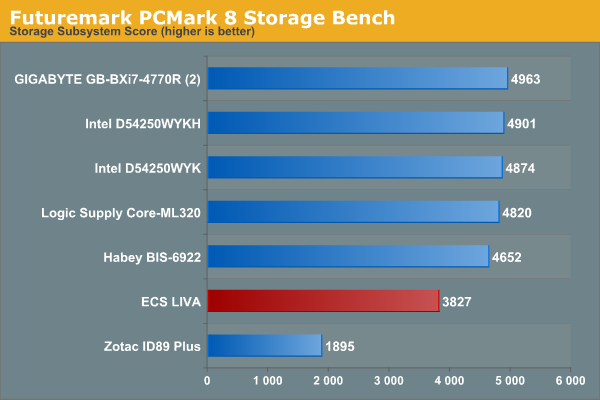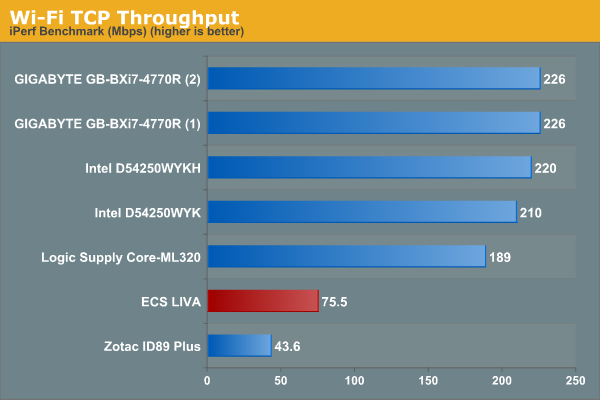ECS LIVA Review: The Nettop Rises Again
by Ganesh T S on July 18, 2014 9:15 AM ESTPerformance Metrics
The ECS LIVA was evaluated using our standard test suite for low power desktops. First off, we have some Futuremark benchmarks. PCMark 8 provides various usage scenarios (home, creative and work) and offers ways to benchmark both baseline (CPU-only) as well as OpenCL accelerated (CPU + GPU) performance. We benchmarked the ECS LIVA for OpenCL accelerated performance in all three usage scenarios. PCMark Suite from PCMark 7, as well as 3D Mark benchmarks were also run. All the Futuremark benchmark numbers are presented in the table below.
| ECS LIVA - Futuremark Benchmarks | |
| Benchmark | Score |
| PCMark 8 (Home OpenCL) | 1035 |
| PCMark 8 (Creative OpenCL) | 766 |
| PCMark 8 (Work OpenCL) | 1135 |
| PCMark 7 - PCMark Suite | 2215 |
| 3DMark 11 (Entry - 1024x768 - Score) | 374 |
| 3DMark 13 (Cloud Gate Score) | 1015 |
| 3DMark 13 (Ice Storm Score) | 11711 |
Some of the other benchmarks that we processed on the ECS LIVA include Cinebench R15 (OpenGL, single-threaded and multi-threaded), x264 v5.0, 7-zip, TrueCrypt (The Celeron N2806 doesn't have AES-NI support, so the results are on the lower side) and Dolphin emulator.
| ECS LIVA - Miscellaneous Benchmarks | |
| Benchmark | Score |
| Cinebench R15 (OpenGL) | 4.66 |
| Cinebench R15 (Single Threaded) | 31 |
| Cinebench R15 (Multi-Threaded) | 49 |
| x264 v5.0 Pass 1 | 8.67 fps |
| x264 v5.0 Pass 2 | 1.51 fps |
| 7z Compression | 1926 |
| 7z Decompression | 3305 |
| TrueCrypt | 109 MBps |
| Dolphin Emulator | 3032 s |
Network & Storage Subsystem Evaluation
We have recently started analyzing the storage and networking credentials of mini-PCs under review. On the storage side, one option would be repetition of our strenuous SSD review tests on the drive(s) in the PC. Fortunately, to avoid that overkill, PCMark 8 has a storage bench where certain common workloads such as loading games and document processing are replayed on the target drive. Results are presented in two forms, one being a benchmark number and the other, a bandwidth figure. We ran the PCMark 8 storage bench on selected PCs and the results are presented below.


We find that the eMMC solution in the ECS LIVA nicely slots in between HDD-based solutions and SSD-based ones. For the price point of the product, this is a very good choice (though we wouldn't have objected to 64 GB eMMC coming in as default).
On the networking side, we restricted ourselves to the evaluation of the WLAN component. Our standard test router is the Netgear R7000 Nighthawk configured with both 2.4 GHz and 5 GHz networks. The router is placed approximately 20 ft. away, separated by a drywall (as in a typical US building). A wired client (Zotac ID89-Plus) is connected to the R7000 and serves as one endpoint for iPerf evaluation. The PC under test is made to connect to either the 5 GHz (preferred) or 2.4 GHz SSID and iPerf tests are conducted for both TCP and UDP transfers. It is ensured that the PC under test is the only wireless client for the Netgear R7000. We evaluate total throughput for up to 32 simultaneous TCP connections using iPerf and present the highest number in the graph below. The ECS LIVA Wi-FI card is not dual-band capable, and hence, it was conencted to the 2.4 GHz SSID.

In the UDP case, we try to transfer data at the highest rate possible for which we get less than 1% packet loss.











55 Comments
View All Comments
rheinlds - Friday, July 18, 2014 - link
It would be good on ECS's part to integrate a Bay Trail-M part with Quick Sync enabled in the LIVA kits. 32 GB of eMMC turns out to be very less after installing a couple of Windows updates. 64 GB should be the minimum, particularly since flash storage needs plenty of free capacity in order to maintain performance.In the Section above "...32 GB of eMMC turns out to be very less after installing a couple of Windows Updates..." Something seems to be missing from this sentence.
ddriver - Friday, July 18, 2014 - link
And 4 gigs of ram. With the price of ram being so low, it should be considered a crime to cripple x86 machines by installing only 2 gigs of ram.phoenix_rizzen - Friday, July 18, 2014 - link
It depends what you want to use them for.As an HTPC, more than 2 GB of RAM is really a waste, as you'll never use even that much (unless something goes horribly wrong with the running apps).
I have 3 homebuilt HTPCs at home (Athlon-XP w/1.5 GB of RAM running Windows XP; Athlon II X3 w/4 GB of RAM running Windows 7; Core2Duo w/2 GB of RAM running Windows 7) all running Google Chrome for Netflix and Plex Web. None of them even come close to using all the RAM.
Sure, if you're going to be doing a bunch of other tasks, then having more than 2 GB would be necessary. But as a pure HTPC, it's not required.
leexgx - Saturday, July 19, 2014 - link
2GB should be enough for windows 8 but could eat quite easily windows alone uses 1GB at least (i do not bother with any thing less then 4GB (even if the system is 32bit 3.25-3.5GB is usable as i seen some systems sitting at 2GB of ram and up to 3GB just checking for updates if office is installed)and 32GB for windows 8 is pushing it as well
johnny_boy - Sunday, July 20, 2014 - link
Depends, of course, on use case. I have an undervolted A10-5800K in my HTPC which I also use for gaming and dedicate 1gb ram for iGPU use. I also prefer to leave all the apps I use open so I don't haveto keep resstarting them. That doesn't leave much ram left, and I am running a relatively lean linux distro.DanNeely - Friday, July 18, 2014 - link
The bigger problem is just that eMMC is slow. I've got a last generation atom tablet/laptop hybrid with eMMC flash. It's tolerably fast 98% of the time, the other 2% something is thrashing the IO system and the flash is showing 100% load in task manager and ~4MB/sec throughput.kyuu - Friday, July 18, 2014 - link
Is your eMMC filled up? Just like with SSDs, you really have to keep a certain amount of it free in order to prevent speed degredation. In eMMC's case, the consequences will be more severe since it isn't nearly as fast as a proper SSD to begin with.Nowadays, eMMC is really pretty decently fast. Beats the hell out of an HDD. The main issue is that companies continue to insist on including so little of it, despite it being cheap as dirt.
jospoortvliet - Sunday, July 20, 2014 - link
As a media center pc, you would be an idiot to want to incur the performance and especially maintenance overhead of Windows... Download an xbmc Linux and be done. Memory and disk pace won't be an issue and an end user won't see any difference - yet no costs and no work keeping Windows safe and running. Right tool for the right job, people...djfourmoney - Wednesday, July 23, 2014 - link
XBMC -Tuner support is very limited to networked tuners and cable cards. I have DirecTV, none of the capture devices available work with Linux, especially in HD.
XBMC also has constant problems with the YouTube add-on. It's hardly updated and with Google often changing something in the code with YouTube, things like log-in gets botched up in XBMC. Last time I logged out believing it was another issue but the truth was a connection issue, U-Verse had gone down.
But I tried to log back in and I have yet to do the .py correction to allow log-in again. This would never be an issue with Smart TV's or Smart devices, they are updated and always work.
Windows has always been safe, don't visit silly sites and don't open email you don't know, pretty simple, not that you would be opening email on your HTPC????
I have a Llano based HTPC (upgraded from Athlon XP, Black Edition OC). Was able to remove the HD4670 (put in my mom's machine), cut down power usages quite a bit, Sliverlight Full Screen isn't an issue, maybe 20% CPU usage. Otherwise it's nearly idle on anything else. No driver issues which seems to always impact the performance of AMD hardware on Linux.
Finally there hasn't been a DVR program more solid or more reliable than Windows Media Center. The cost of adding it to Windows 8 is negligible and I also have 1GB dedicated to the GPU side of the APU, runs GRID and GRID 2 without issue, everything turned up (GPU slightly OC), but I play games on my PS3 not the PC but for some emulation.
HUBEMX - Sunday, July 20, 2014 - link
Anandtech: You should try OPENELEC!